The Parallel Worlds of Poul Anderson’s Operation Chaos
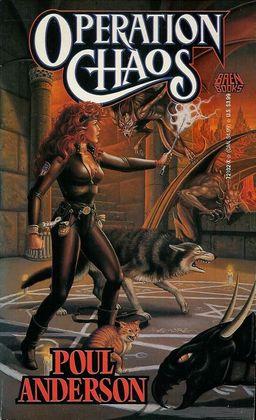 I may have got ahead of myself by reporting on three novels of 1960. This is because, in opening Operation Otherworld, an omnibus edition of Poul Anderson’s Operation Chaos and Operation Luna, I learned that Operation Chaos was not merely published in 1971 but also as four novellas or novelettes beginning in 1956. Their titles mark the four episodes that make up Operation Chaos: “Operation Afreet,” “Operation Salamander,” “Operation Incubus,” and “Operation Changeling.” All were published in The Magazine of Science Fiction and Fantasy.
I may have got ahead of myself by reporting on three novels of 1960. This is because, in opening Operation Otherworld, an omnibus edition of Poul Anderson’s Operation Chaos and Operation Luna, I learned that Operation Chaos was not merely published in 1971 but also as four novellas or novelettes beginning in 1956. Their titles mark the four episodes that make up Operation Chaos: “Operation Afreet,” “Operation Salamander,” “Operation Incubus,” and “Operation Changeling.” All were published in The Magazine of Science Fiction and Fantasy.
This book in many ways is a return to or continuation of the ideas first presented in Three Hearts and Three Lions. Indeed, Sandra Miesel in Against Time’s Arrow spends most of her analysis of Anderson’s concepts of Chaos and Law in this book rather than in the former. I, however, found myself more interested in Anderson’s presentation of parallel worlds and his technique of introducing the concept. The very first words:
Hello, out there!
If you exist, hello!
We may never find out. This is a wild experiment, test of a wilder hypothesis. But it is also a duty.
I lie dream-bound, only half aware of my world. They are using me to call for them across the time streams because that which happened to me, so many years ago, has left its traces beneath my ordinariness; they believe a message thought by me has a better chance of finding a resonance in you than if it came from almost anyone else…
It is only a philosophical idea, that time has more than one dimension, that any number of entire universes may coexist, some utterly alien, some whose differences from ours are perhaps too subtle to detect…. Why am I dreaming in this language? It isn’t my normal speech. The preparations have cast me into a strange state. Damnation, I will be myself, not only myself again when I wake tomorrow but myself now and throughout the night…. Earths where Lee won at Gettysburg or Napoleon at Waterloo; Earths where Mithraism won over Christianity in the Roman Empire; Earths where Rome never was; Earths where another animal than man evolved toward a rational soul, or none did; Earths, whole cosmoses where the laws of nature are something else, where it is possible to do what we forever cannot, but they never will accomplish what we do with ease….
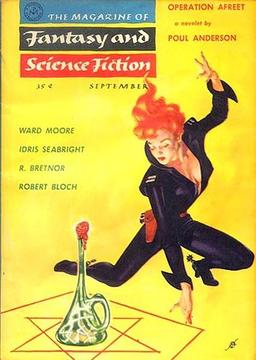 [Click on the images for bigger versions.]
[Click on the images for bigger versions.]
Fun stuff. Seeing as how the four episodes making up this novel were published separately elsewhere, I have the feeling that this opening was constructed as a genius way of introducing the reader of the book to the concept. Alas, though, this is a book end that lacks a second. The speaker here, who we soon learn is Steven Matuchek, a werewolf on a parallel Earth, is reaching out in this psychic way to warn “us” about this multi-cosmic war.
In fact, I at first thought that perhaps Anderson was attempting a highly meta device of convincing the reader that this “book” has been manifested for the reader – you – from a neighboring dimension and that you now are being enlisted in this multi-cosmic war between Law and Chaos. But then the narrator only succeeds in delivering the “warning” by relating his own rambling story.
I kind of suspect that many “interludes” in this book are interpolations serving the function of trying to knit all these episodes together. Apparently Steve and his wife-to-be, in a later episode his wife, Ginny, are specific targets of some great, disembodied malevolence, the “Solipsist” in perpetual struggle against the “One.”
At times Steve gets to listen in on this Spirit’s thoughts, and he learns that he and Ginny and their unborn daughter will be constant threats to this Enemy. It all ends up being a touch anticlimactic, when in the culmination of what certainly originally was “Operation Changeling,” Steve and Ginny’s daughter Valeria is rescued out of the hell into which she had been abducted.
I must confess that perhaps I didn’t read with enough attention, but I somehow missed just why the child was abducted, and perhaps Anderson intended that it should seem like the forces of Chaos only precipitated their own downfall by, through this abduction, setting into motion Steve and Ginny’s invasion of Hell itself. Yes, Demons and Devils and others (like the Eastern Caliphate of WWII rather than the Axis powers that we know on this Earth) serve Chaos, and Chaos is identified as Evil.
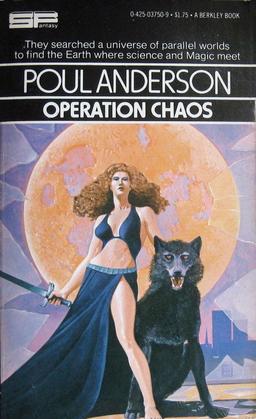 I certainly don’t know enough about the entire history of science fiction and fantasy, but it seems probable to me that with this work Anderson was anticipating or pioneering many recognizable tropes of the genre. His prologue is an experiment with the epistolary form, which Gene Wolfe has made striking use of in the Book of the New Sun when that book literally is jettisoned into Space, or with the letters that constitute what is the novel being sent across the dimensional rift in The Wizard Knight.
I certainly don’t know enough about the entire history of science fiction and fantasy, but it seems probable to me that with this work Anderson was anticipating or pioneering many recognizable tropes of the genre. His prologue is an experiment with the epistolary form, which Gene Wolfe has made striking use of in the Book of the New Sun when that book literally is jettisoned into Space, or with the letters that constitute what is the novel being sent across the dimensional rift in The Wizard Knight.
In terms of content, this book is some parts alternate history, some parts slipstream. Anderson also experiments with the “laws” of the universe – or universes. In the version of Earth that Steve inhabits, just about everything that the Enlightenment folks now believe is error is “real” in a fashion much like what we see in modern comic books. Modern science is real, but also ancient mythologies, and folk beliefs involving magic.
Even the dualistic struggle between God and Satan is real. In comparison to modern comic books universes, the only thing lacking in Anderson’s parallel world is the presence of alien races and technologies.
We have talked about this “pot of everything” in Anderson’s work before, particularly in relation to The Broken Sword, and in Three Hearts and Three Lions fantasy tropes are interpreted through a scientific lens. In the modern world represented in Operation Chaos, an understanding of magic and technology is often combined, as it often is in comic books. Anderson also appears to be experimenting with metaphysical science fiction along the lines of Philip K. Dick. Sometimes Operation Chaos reads like the theological form developed by Charles Williams and C.S. Lewis.
If Anderson pioneers some of these qualities, it is understandable, because of their nascent stages, that some of it is unconvincing. Often his commingling of magic and technology is reduced to humorous puns and analogies. And there is little real extrapolation of how technology would evolve at all in a world in which many of its achievements could be effected through the use of better-established magic.
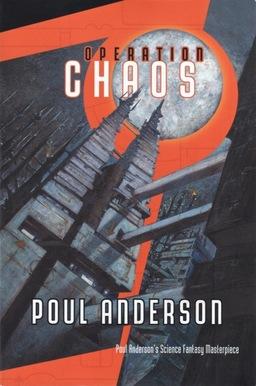 In the fashion of PKD, Anderson creates a gnostic form of Christianity, one that believes in a second “rock” in the apostle John rather than in Peter. This sect unwittingly is in service to Satan. Steve, or perhaps even Anderson, starts sounding surprisingly conservative in the following passages, when he expresses his concern about the idealists and revolutionaries that form the majority of the Johaninne sect.
In the fashion of PKD, Anderson creates a gnostic form of Christianity, one that believes in a second “rock” in the apostle John rather than in Peter. This sect unwittingly is in service to Satan. Steve, or perhaps even Anderson, starts sounding surprisingly conservative in the following passages, when he expresses his concern about the idealists and revolutionaries that form the majority of the Johaninne sect.
You hear a lot about long-haired men and short-haired women, bathless bodies and raggedy clothes. Those were certainly present in force. Likewise I identified the usual graybeard radicals and campus hangers-on, hoodlums, unemployables, vandals, True Believers, and the rest. But there were the merely curious, too, who had somehow suddenly found themselves involved. And everyone was tall, short, or medium, fat, thin, or average, rich, poor, or middleclass, bright, dull or normal, heterosexual, homosexual, or I know not what, able in some fields, inept in others, interested in some things, bored by others, each with an infinite set of memories, dreams, hopes, terrors, loves – each with a soul.
The first iteration of this episode appeared in 1969 and it is difficult not to wonder what Anderson might have felt about the rising counter-culture and anti-war demonstrations. We could insist on consigning these views solely to Steve, who, as a fictional character, is a member of a military that understandably often falls into a sort of pro-conservative idealistic march-step.
But Steve believes that it is not himself who is in danger of losing his individuality, but these people. He notes how many of them carry signs, “and so it was with the faces – worse, the brains behind them – had become nothing but placards with slogans written across.”
He continues:
Don’t misunderstand me. I wouldn’t think much of a youngster who never felt an urge to kick the God of All Things As They Are in his fat belly. It’s too bad that most people lose it as they get old and fat themselves. The Establishment is often unendurably smug and stupid; the hands it folds so piously are often bloodstained.
And yet… and yet… it’s the only thing between us and the Dark Ages that’d have to intervene before another and probably worse Establishment could arise to restore order. And don’t kid yourself that none would. Freedom is a fine thing until it becomes somebody else’s freedom to enter your house, kill, rob, rape, and enslave the people you care about. Then you’ll accept any man on horseback who promises to bring some predictability back into life, and you yourself will give him his saber and knout.
Therefore isn’t our best bet to preserve this thing we’ve got? However imperfectly, it does function; and it’s ours, it shaped us, we may not understand it any too well but surely we understand it better than something untried and alien. With a lot of hard work, hard thinking, hard-nosed good will, we can improve it.
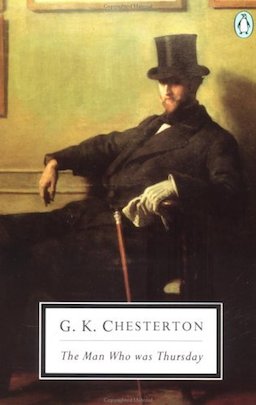 A lot of this dialectic reminds me of the one at the heart of Chesterton’s The Man Who Was Thursday, a “nightmare” that results in a divine epiphany that two sides of a cosmic struggle have been on the same side all along. In fact, the two sides in that work, Order vs. Anarchy, are naturally similar to Anderson’s own Law vs. Chaos. Unlike Chesterton’s remarkable philosophical or theological conclusion, however, Anderson’s sides remain at odds – at unreconciliable odds. As with Chesterton, Anderson’s Johaninne Church believes that it is doing good and right, but ultimately it is serving the side of Evil. The Johaninne Church is being used to destroy when really, according to Steve, it should participate in reform of the existing structure. But, as with Three Hearts and Three Lions, I remain unconvinced of any basis through which Anderson might conscientiously identify “Chaos” with “Evil.”
A lot of this dialectic reminds me of the one at the heart of Chesterton’s The Man Who Was Thursday, a “nightmare” that results in a divine epiphany that two sides of a cosmic struggle have been on the same side all along. In fact, the two sides in that work, Order vs. Anarchy, are naturally similar to Anderson’s own Law vs. Chaos. Unlike Chesterton’s remarkable philosophical or theological conclusion, however, Anderson’s sides remain at odds – at unreconciliable odds. As with Chesterton, Anderson’s Johaninne Church believes that it is doing good and right, but ultimately it is serving the side of Evil. The Johaninne Church is being used to destroy when really, according to Steve, it should participate in reform of the existing structure. But, as with Three Hearts and Three Lions, I remain unconvinced of any basis through which Anderson might conscientiously identify “Chaos” with “Evil.”
What exactly might Destruction and Chaos actually look like if Evil’s ends are achieved on Earth? The reader is given some idea of this when the heroes enter Hell in order to rescue their daughter Val. It reminds one of many of the places described in The Manual of the Planes, a book first written by Jeff Grubb. I have heard more than one person remark that these places are interesting to read about but that few of them are anywhere in which any gamer would actually want to play. Anderson writes:
How to explain? Suppose you were a Flatlander, a mythical creature (if any creature is mythical) of two space dimensions, no more. You live in a surface. That’s right, in. If this is a plane, its geometry obeys the Euclidean rules we learn in high school: parallel lines don’t meet, the shortest distance between two points is a straight line, the angles of a triangle total 180 degrees, et cetera. But now imagine that some three-dimensional giant plucks you out and drops you into a surface of different shape. It might be a sphere, for example. You’ll find space fantastically changed. In a sphere, you must think of lines in terms of meridians and parallels, which mean they have finite length; in general, distance between points is minimized by following a great circle; triangles have a variable number of degrees, but always more than 180 – You might well go mad. Now imagine cones, hyperboloids, rotated trigonometric and logarithmic curves, Mobius bands, whatever you can.
And now imagine a planet which is all water, churned by storms and not constrained by the ordinary laws of physics. At any point its surface can have any form, which won’t even stay constant in time. Expand the two dimensions into three; make it four for the temporal axis, unless this requires more than one, as many philosophers believe; add the hyperspace in which paranatural forces act; put it under the rule of chaos and hatred: and you’ve got some analogy to the hell universe.
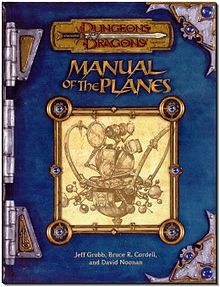 For people from the “natural” plane, a distinguishing feature of Hell is that no lines go in the direction in which they appear to go. One could take two steps and appear in a totally different region far away (if space had any real meaning in this dimension). Hell is non-Euclidean.
For people from the “natural” plane, a distinguishing feature of Hell is that no lines go in the direction in which they appear to go. One could take two steps and appear in a totally different region far away (if space had any real meaning in this dimension). Hell is non-Euclidean.
Despite all this, however, Anderson’s “imagination of the weird” has its limits. The demons have physical form. The humans maintain their own. All creatures are able to interact with each other. Despite this creative limitation, however, Anderson’s shorthand descriptions of the demons may inspire a number of new entries into the Monster Manual:
We focused on a single band of demons. No two looked alike; vanity runs high in hell. A body covered with spines, a tentacles dinosaur, a fat slattern whose nipples were tiny grinning heads, a flying swine, a changeable blob, a nude man with a snake for a phallus, a face in a belly, a dwarf on ten-foot pencil-thin legs, and less describable sights –
Next up, I’m going to break my mostly-chronological survey by moving on to Operation Luna, a sequel to Operation Chaos published more than twenty years later! It will be interesting to see how Anderson’s political, philosophical, and theological views change over time, if they change at all. And Operation Luna is a straightforward novel rather than a series of novellas stitched together into a longer work. That should exhibit some interesting influences as well.
I’m a big fan of OPERATION CHAOS. Anderson dedicated it to Robert Heinlein, “who first incorporated magic”, but I think Anderson handled a milieu in which sorcery (with consistent laws) is part of the normal pace of twentieth century American life, better than Heinlein. Certainly Steve and Ginny’s motive for invading Hell itself – to rescue their infant daughter – is more powerful than that of Heinlein’s protagonists. And I loved the touch of Steve and Ginny having the help of the spirits of Lobachevsky and Janos Bolyai to navigate their way through the chaotic space-time of the Hell universe when they arrive. (“No living mathematician could do it.
But the greatest geometers are dead.”)